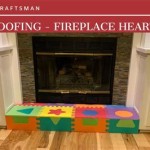Faux Fieldstone Fireplace: Aesthetics, Installation, and Considerations
A fireplace serves as a focal point in many homes, providing warmth and visual appeal. Natural fieldstone has long been a popular material for fireplace construction due to its rustic charm and enduring quality. However, the cost and complexity associated with installing natural fieldstone have led to the development and widespread adoption of faux fieldstone alternatives. A faux fieldstone fireplace offers a cost-effective and aesthetically versatile solution for homeowners seeking the look of natural stone without the drawbacks of its authentic counterpart.
Faux fieldstone, often referred to as manufactured stone veneer, is a composite material designed to replicate the appearance of natural fieldstone. It is typically composed of a mixture of Portland cement, aggregates, and pigments, molded to create realistic textures and color variations. These manufactured stone pieces are then adhered to a prepared surface to create the illusion of a solid fieldstone structure. This article will delve into the advantages, installation process, and key considerations when opting for a faux fieldstone fireplace, providing comprehensive information for homeowners and contractors alike.
Advantages of Faux Fieldstone Fireplaces
Choosing faux fieldstone over natural fieldstone for a fireplace offers several distinct advantages. These advantages primarily revolve around cost-effectiveness, ease of installation, design flexibility, and reduced maintenance requirements. Understanding these benefits is crucial in making an informed decision about fireplace materials.
Cost-Effectiveness: One of the most significant advantages of faux fieldstone is its lower cost compared to natural fieldstone. The extraction, transportation, and cutting of natural stone contribute significantly to its overall price. Faux fieldstone, being manufactured in a controlled environment, eliminates many of these costs. The lower material cost, coupled with the potential for reduced labor costs due to easier installation, makes faux fieldstone a budget-friendly option for homeowners. Furthermore, the consistent dimensions and lighter weight of faux stone minimize material waste during installation, further contributing to cost savings.
Ease of Installation: Faux fieldstone is considerably lighter than natural fieldstone, which simplifies the installation process. This lighter weight reduces the structural support required for the fireplace surround, potentially eliminating the need for costly modifications to the existing structure. Furthermore, faux fieldstone is typically manufactured in modular units, facilitating a more straightforward and faster installation. The uniform size and shape of the pieces allow for easier cutting and fitting, minimizing the need for specialized tools and expertise. This ease of installation can translate to lower labor costs for homeowners opting for professional installation or make it a more manageable DIY project for experienced individuals.
Design Flexibility: Faux fieldstone offers a wide range of design possibilities that may not be readily available with natural stone. Manufacturers can create faux fieldstone in various shapes, sizes, colors, and textures, allowing homeowners to customize the look of their fireplace to match their individual style and the overall aesthetic of their home. Whether a homeowner prefers a rustic, traditional look or a more contemporary design, faux fieldstone can be tailored to achieve the desired effect. This design flexibility extends to the ability to replicate different types of natural stone, providing homeowners with a broader selection of visual options. The consistent color and texture of manufactured stone also ensure a more uniform and predictable appearance compared to the natural variations inherent in natural stone.
Reduced Maintenance: Faux fieldstone is generally easier to maintain than natural fieldstone. Its manufactured composition makes it less porous and therefore less susceptible to staining and water damage. While natural stone may require periodic sealing to protect it from the elements, faux fieldstone typically does not require this level of maintenance. Regular cleaning with a mild soap and water solution is usually sufficient to keep faux fieldstone looking its best. The durability of the material also minimizes the risk of chipping or cracking, further reducing the need for repairs. This low-maintenance characteristic makes faux fieldstone a practical choice for homeowners seeking a visually appealing fireplace surround that requires minimal upkeep.
Installation Process for a Faux Fieldstone Fireplace
The installation of a faux fieldstone fireplace involves several key steps, from preparing the surface to applying the individual stone pieces. Proper preparation and adherence to manufacturer guidelines are crucial for ensuring a durable and aesthetically pleasing finished product. The following outlines the general steps involved in installing a faux fieldstone fireplace.
Surface Preparation: The first step in the installation process is to prepare the surface to which the faux fieldstone will be applied. This typically involves ensuring that the surface is clean, dry, and structurally sound. If the existing surface is painted or coated, it may be necessary to roughen it up to provide a better bonding surface for the mortar. In many cases, a layer of metal lath is applied to the surface to provide additional support and improve adhesion. The metal lath is typically secured to the surface using nails or screws.
Mortar Application: Once the surface is prepared, mortar is applied to the back of each faux fieldstone piece. The mortar should be specifically designed for use with manufactured stone veneer and should be mixed according to the manufacturer's instructions. A notched trowel is typically used to create ridges in the mortar, which helps to ensure a strong bond with the surface. The amount of mortar applied should be sufficient to create a solid connection without squeezing out excessively from the sides of the stone.
Stone Placement: With mortar applied to the back of each piece, the faux fieldstone is carefully placed onto the prepared surface. The stones should be arranged in a random pattern to mimic the natural appearance of fieldstone. Spacing between the stones can vary depending on the desired look, but a consistent spacing is generally recommended for a more uniform appearance. As each stone is placed, it should be pressed firmly against the surface to ensure good adhesion. Any excess mortar that squeezes out from the sides of the stone should be removed promptly.
Grouting or Dry-Stacking: After the faux fieldstone is installed, the joints between the stones can be grouted or left as a "dry-stack" appearance. Grouting involves filling the joints with mortar, while dry-stacking leaves the joints open. The choice between grouting and dry-stacking depends on the desired aesthetic and the specific type of faux fieldstone being used. If grouting is chosen, the mortar should be applied carefully and evenly, and any excess mortar should be cleaned off the surface of the stones. If dry-stacking is chosen, care should be taken to ensure that the stones are tightly fitted together to minimize the appearance of gaps.
Sealing (Optional): While not always necessary, sealing the finished faux fieldstone fireplace can provide additional protection against staining and water damage. A sealant specifically designed for use with manufactured stone veneer should be applied according to the manufacturer's instructions. Sealing can also enhance the color and texture of the stone, providing a richer and more vibrant appearance.
Key Considerations When Choosing and Installing Faux Fieldstone
Selecting and installing a faux fieldstone fireplace involves several factors beyond cost and aesthetics. Understanding these considerations ensures the selection of a product that meets specific needs, adheres to safety standards, and provides long-lasting performance. Factors such as fire safety, weight limitations, and proper maintenance are critical to consider before proceeding with installation.
Fire Safety: When installing a faux fieldstone fireplace, fire safety is paramount. The materials used must be fire-resistant or non-combustible, especially in areas close to the firebox. Ensure that the faux fieldstone is rated for use in fireplace applications and that it meets all relevant building codes and regulations. Consider the proximity of the faux fieldstone to the firebox opening and the potential for sparks or embers to come into contact with the material. In some cases, additional fireproofing measures may be necessary, such as the installation of a fire-resistant backer board or a heat shield. Consulting with a fire safety professional can help ensure that the installation meets all necessary safety requirements.
Weight Limitations: Although lighter than natural fieldstone, faux fieldstone still has weight that the existing structure must support. Assess the weight-bearing capacity of the floor and wall where the fireplace will be installed. If the structure is not strong enough to support the weight of the faux fieldstone, reinforcement may be required. This could involve adding additional support beams or strengthening the existing framing. Consulting with a structural engineer can help determine the weight-bearing capacity of the structure and identify any necessary reinforcement measures.
Maintenance and Cleaning: Proper maintenance and cleaning are essential for preserving the appearance and longevity of a faux fieldstone fireplace. Regular cleaning with a mild soap and water solution is typically sufficient to remove dirt and grime. Avoid using harsh chemicals or abrasive cleaners, as these can damage the surface of the stone. Inspect the fireplace regularly for any signs of damage, such as cracks or chips. Repair any damage promptly to prevent further deterioration. Depending on the specific type of faux fieldstone, periodic sealing may be recommended to protect it from staining and water damage. Following the manufacturer's recommendations for maintenance and cleaning will help ensure that the fireplace remains beautiful and functional for years to come. Consider using a sealant specifically designed for faux stone to help protect it from the elements and make it easier to clean.

Fireplace Makeover With Faux Stone Diy Idea Hometalk

Stone Fireplace Design And Remodel

Fieldstone Fireplace Cottage S Facing

Real Stone Veneer River Rounds Stonewood S

Stone Fireplace Design And Remodel

Use A Faux Stone Fireplace For Your Log Home To Reduce Costs

Thin Stone Veneers Make A Fireplace Update Easy Swenson Granite 100 Natural Stones

Bucks County Dressed Fieldstone Fireplace W Rustic Mantle Home Remodel Design

Stone Fireplace Makeover Part 2 Faux Whitewash Organized Ish

Carlton Fieldstone Harvest Faux Stone Panels Create An Attractive Corner Fireplace Design Fauxstone Propane
Related Posts








